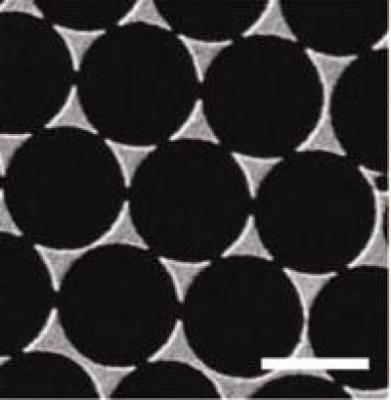A team of scientists from the Lawrence Berkeley National Laboratory (Berkeley Lab) of the U.S. Department of Energy and the University of California Berkeley is the first to develop a realistic application of optical nanoantennas in the field of cell membrane biology.
 An array of gold nanoparticles in the shape of triangles that are paired in a tip-to-tip formation, like a bow-tie, can serve as optical antennas, capturing and concentrating light waves into well-defined hot spots, where the plasmonic effect is greatly amplified. (Courtesy of Jay Groves, Berkeley Lab, UC Berkeley, HHMI)
An array of gold nanoparticles in the shape of triangles that are paired in a tip-to-tip formation, like a bow-tie, can serve as optical antennas, capturing and concentrating light waves into well-defined hot spots, where the plasmonic effect is greatly amplified. (Courtesy of Jay Groves, Berkeley Lab, UC Berkeley, HHMI)
The research team headed by Jay Groves has devised a method for tying synthetic lipid membranes using several millions of gold ‘bowtie’ nanoantennas, which can amplify the intensity of a protein’s Raman or fluorescent optical signal traversing a plasmonic ‘hot-spot’ several hundred times without touching the protein.
Groves informed that his team was able to produce several millions of gold nanoantennas in a synthetic membrane using a combination of plasma processing and colloidal lithography methods. The plasma processing creates well-defined spacing between every gold triangle pair in the final arrangement that has a tip-to-tip space between adjacent gold nanotriangles in the range of 5-100 nm.
With the help of the colloidal lithography method, the team was able to shadow mask a substrate using a self-assembling polymer sphere hexagonal monolayer to deposit the gold nanoparticles subsequently. The removal of the colloidal mask leaves behind huge arrays of gold nanotriangles and nanoparticles, upon which the synthetic membrane can be fabricated.
The novel artificial membranes made of fluid lipid molecule bilayers are the first of its kind biological platforms that are capable of integrating fixed nanopatterning with the fluid bilayer mobility.
Groves explained that after embedding the synthetic membranes over the gold nanoantennas, the team is now able to track the paths of freely diffusing single proteins as they orderly traverse, and are improved by the multiple voids between the triangles, allowing the study of a practical system such as a cell without statically entrapping its molecules.
The technique can be used to study single biomolecules in terms of their surrounding community. Groves’ team was the first to fabricate nanoantennas in a fluid membrane to monitor each molecule of a system when it traverses the antenna array.
Source: http://www.lbl.gov/